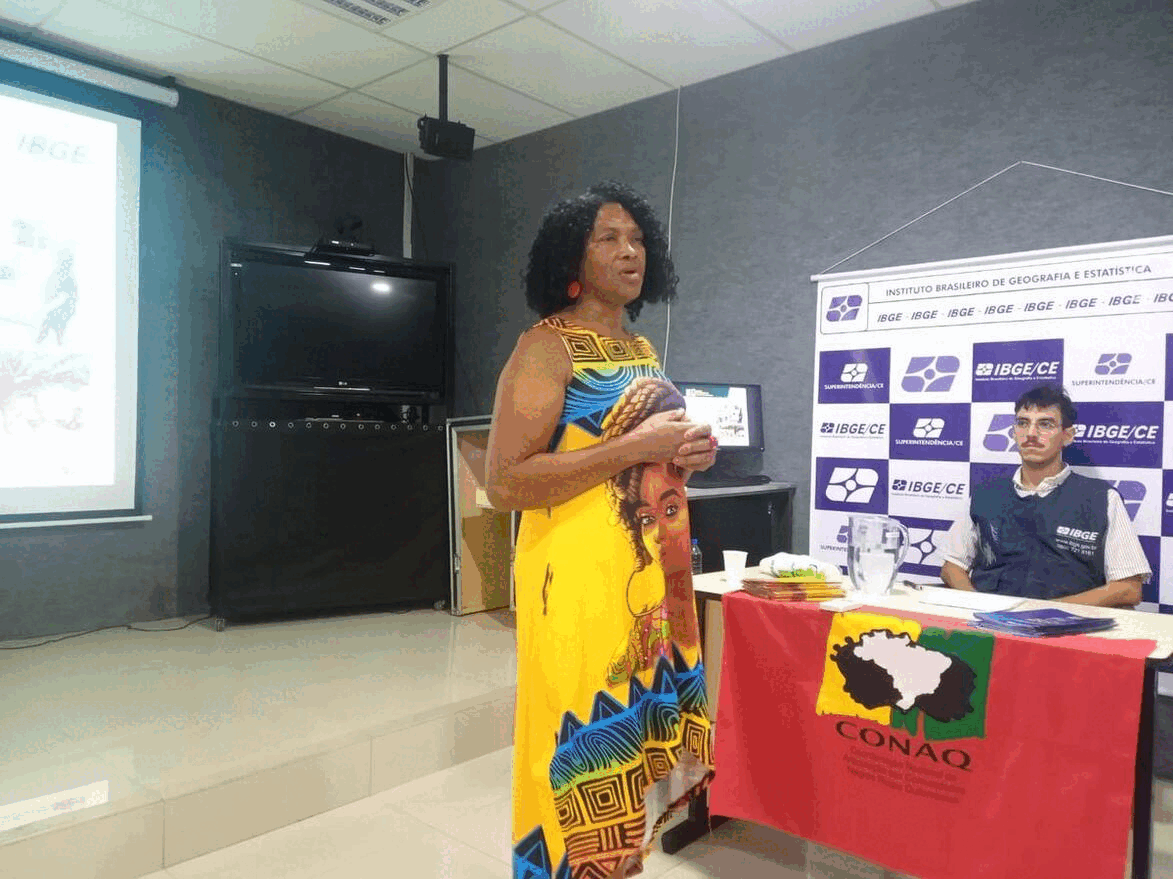SES-CE and Conaq present unprecedented data on Quilombolas in Ceará
August 01, 2023 15h12 | Last Updated: August 03, 2023 16h39
In the afternoon of last Thursday (27), the sector of Information Dissemination (SDI) of the IBGE State Superintendence in Ceará (SES-CE) conducted another event disseminating the results of the 2022 Population Census. This time, the data released referred to the Quilombola Population in the State of Ceará. It is an unprecedented set of information about these communities, since the 2022 Census was the first survey of national coverage to count people who self-declared themselves as quilombolas.
The presentation of the data took place in the headquarters of SES-CE, conducted by Fábio Jota, an anthropologist and Census Analyst of Traditional Peoples and Communities. The officer described all the innovations introduced in every step of the enumeration of quilombola persons. The major concepts and definitions used to support the work were explained as well. Then the data themselves were presented, related to the population and households. “These data are very important, since they are the first official statistics about quilombola persons in the Brazilian history. These data will be used to develop public policies, as well as to advance in the land regularization of quilombola territories,” pointed out the anthropologist.

Anthropologist Fábio Jota conducted the presentation of the First Results of the 2022 Census for the Quilombola Population in Ceará
The National Coordination of Articulation of Rural Quilombola Black Communities (Conaq), a major partner of the IBGE in every step of the enumeration of these communities, was also invited to take part in the dissemination. Aurila Maria Souza Sales, known as Aurila Quilombola, leader of the Quilombola Community of Nazaré, located in the municipality of Itapipoca, represented the institution in the State of Ceará. “It was said that Ceará didn´t have black people. But a soon as we leave the cities and go to the interior, we see the quilombola population. We are very happy with this Census result. I thought that we would enumerate 15 thousand quilombolas in Ceará, and we reached nearly 24 thousand. I think this figure might double in the next Census, because as soon as the persons see it, they will self-declare themselves as quilombolas,” celebrated the quilombola leader.

Aurila Quilombola, Conaq´s leader in Ceará, celebrated the first pioneering data on quilombola communities in the State
Quilombola population and households
According to the data released by the 2022 Population Census, Ceará has 23,955 quilombola persons, the equivalent to 1.8% of the total number of quilombolas in Brazil and to 2.6% of the total number of quilombolas in the Northeast Region. Therefore, the State ranks in the tenth position among the FUs in absolute numbers of quilombola population.

The 2022 Census counted nearly 24 thousand quilombolas in Ceará
The quilombola population is present in 68 municipalities in Ceará, and represents 0.27% of the entire resident population of the State. Therefore, Ceará is the 16th FU in terms of quilombola presence, standing below the national average (0.65% of the residents in Brazil are quilombolas).
The five municipalities in Ceará with more quilombolas are, respectively: Caucaia (2,615 quilombola persons), Horizonte (2,282), Salitre (1,804), Tururu (1,422) and Tauá (1,069). On the other hand, the five municipalities in Ceará with the highest proportion of quilombolas among the resident population are, respectively: Salitre (10.85% of the inhabitants in the municipality are quilombolas), Tururu (9.23%), Moraújo (8.98%), Potengi (5.09%) and Tamboril (3.95%).
Ceará has 8,379 Occupied Permanent Private Households (DPPOs) with at least one quilombola resident. It represents 0.28% of the total number of DPPOs in the State. In the households in which at least one quilombola person lives, the average number of residents is 3.17, the same figure registered at national level. It is worth highlighting that this average (3.17) is above the average number of residents per household in the State (2.90) and in Brazil (2.79), which points out that quilombola households usually have larger number of persons living.
Another important information is that, in the households in Ceará with at least one quilombola person, the quilombola presence is nearly total: 90.13% of the residents are quilombolas. This percentage is even higher than that of Brazil: 88.15%. It shows that such households are not used to have just one quilombola living among several non-quilombola persons, but rather that virtually everyone in the house self-declare themselves as quilombolas.
Regularization of quilombola territories
Based on data provided by the National Institute for Colonization and Agrarian Reform (INCRA) and by state offices in charge of land regularization in the states and municipalities, the IBGE noticed that Ceará has 15 Officially Delimited Quilombola Territories (TQODs), i.e., 15 quilombola territories that are experiencing one of the six phases of the regularization process. TQODs were those that had a formal delimitation in the records of land regularization offices up to July 31, 2022 (reference date of the Population Census).
In Ceará, 7,879 is the total number of residents within the TQODs, being 4,595 quilombola persons (58.32%) and 3,284 non-quilombola persons (41.68%). The 4,595 quilombola persons living within the TQODs in Ceará represent 19.18% of the total quilombola population in the State. As a result, 19,360 quilombola persons in Ceará (80.82% of the total) live outside the areas formally delimited and recognized.
Finally, the data captured by the IBGE with land regularization offices reveal none Titled Quilombola Territory in Ceará. In other words, no quilombola territory in the State is under the land status of titled, the most advanced in the land regularization process and the one that really guarantees the ownership of land to the quilombola community.
